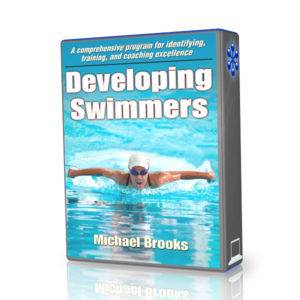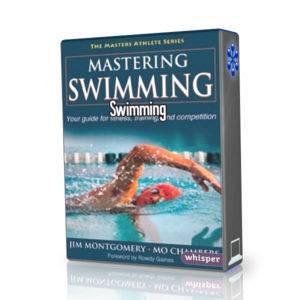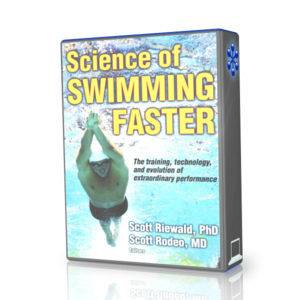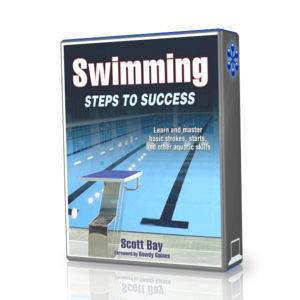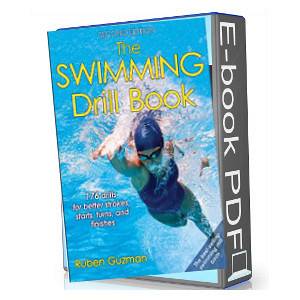The butterfly uses the dolphin kick, where the legs move up and down simultaneously resembling the action of a dolphin's tail. In fact it is more than a leg motion. It is an entire body motion. It is more accurately called simply the dolphin. Done right it is one of the most powerful movements in swimming. The dolphin uses a whip-like motion that starts high in the body, and moves down through the trunk, hips and legs, and ends up with the feet snapping down and up again. The dolphin provides rhythm and balance to the other actions of the stroke, but above all it adds power. A good dolphin makes the butterfly much easier, and much more sustainable. The goal of the following kicking drills for butterfly is to develop an effective, rhythmic and effective dolphin action that benefits the rest of the stroke.
Ribbon Writing
THE PURPOSE OF THIS DRILL
- Understanding the fluid nature of the dolphin
- Generating power high in the body
- Learning to transfer power to the feet
HOW TO DO THIS DRILL
- Step 1 : - Cut a piece of wide ribbon to a length of about fifteen inches. Stand in chest deep water, and hold the ribbon in one hand, with that arm outstretched in front of you, under the water. Begin to sweep your arm down about twelve to fifteen inches, and back up, keeping your hand from breaking the surface of the water at its highest point. Sweep your outstretched arm down and up rhythmically at a rate that the ribbon begins to follow the movement of your arm.
- Step 2 : - Notice how the ribbon creates a sort of S shape as it flows through the water. Notice too, that although the arm holding the ribbon is initiating the movement, it is the free end of the ribbon that is moving more quickly. This is the essence of the dolphin action. While the action is initiated high in the body, it is the feet that exhibit the most motion.
- Step 3 : - Continue making an S or wave with the ribbon, sweeping your outstretched arm down and up through the water. Watch the free end of the ribbon react to the motion of your sweeping arm. Now, without slowing the rhythm of your arm movement, bend at the elbow, and attempt to continue the ribbon's movement using just the lower portion of your arm, from your elbow to your hand. Notice that the wave action of the ribbon diminishes significantly. This is what happens when a swimmer over-bends at the knees doing dolphin.
- Step 4 : - Re-establish your full arm motion, and watch the ribbon again flow through a continuous S shape. Without bending radically at the elbow or wrist, try to make your arm move fluidly through the water, as if your arm was part of the ribbon. This is how a good dolphin works, fluidly, gathering the force of the motion started high in the body and transferring it downward to the feet.

DRILL FEEDBACK CHART
| Problem | Modification |
| My ribbon doesn't make a wave. | Try to make the down and up motion with your arm continuous. Don't slow down as you change directions. Use a smooth, sweeping motion, initiated from the shoulder, rather than from the hand. |
| My ribbon makes a Z not an S. | Try to switch directions more smoothly. Fluidly and rhythmically sweep the ribbon back and forth, and avoid any jerking movements. |
| The free end of my ribbon is not a part of the wave. | Sweep your arm a little faster, and use more depth. Let your arm be long and relaxed until the entire length of the ribbon flows through the wave. |
Deep to Shallow Dolphin
THE PURPOSE OF THIS DRILL
- Practicing full-body dolphin
- Experiencing the forward line of the dolphin
- Achieving a compact dolphin wave
HOW TO DO THIS DRILL
Step 1: At a depth of about six feet, lay face down in the water, arms at your sides. With a firm core and straight spine, bow forward, maintaining a stable hip position. Feel your head lead your body downward toward the bottom of the pool. Allow your legs and feet to follow. Watch your descent carefully, and before reaching the bottom of the pool, come out of your bow by raising your upper body, allowing your legs and feet to follow the same path. As your head rises, your feet should snap downward. At the top of your ascent, your face will clear the water, and you can grab a new breath. Then bow forward again. Repeat this extreme dolphin action several times, following a forward path that is at least four feet of deep.
Step 2: Now move to shallower water, perhaps three feet deep. Lay face down in the water, arms at your sides. With your spine straight and core firm, bow forward, maintaining a high hip position. Feel your body descend downward. Feel your legs and feet follow the same line of descent. Raise your upper body out of your bow before reaching the bottom of the pool. Your legs and feet should follow the same path. As your head rises, feel your feet snap downward. Breathe, then bow forward again, repeating the wave-like dolphin action that passes through a depth of only one and a half feet.
Step 3: Now you have to pretend that you are in water that is only one foot deep. Lay face down in the water, arms at your sides with a straight spine and firm core. Bow forward, maintaining your high hip position. Allow your upper body to descend. Feel your hips, legs and feet react. Quickly, before reaching the bottom of the one-foot deep water, raise your upper body out of the bow. Feel your legs and feet follow quickly. As you head rises, feel your feet snap quickly downward. Breathe then bow forward again, repeating a very compact, yet effective forward wave-like dolphin action that is only a few inches deep.

DRILL FEEDBACK CHART
| Problem | Modification |
| After I breathe, I can't achieve another dolphin. | Be sure you are maintaining a straight spine through your neck, and that you are not raising your chin to breathe. Without this firm spine line, you head will be leading you in a different direction than your body is trying to go. |
| I am not moving forward. | Make sure you are not simply folding in half at the waist, but simply bowing your upper body forward. If you allow your legs to sink as your chest is descending, your forward motion will be reduced. Your legs must follow the same line that your upper body has travelled. |
| I can only make a slight wave in the shallowest water. | Yes, but it is there. Practice condensing all of the power of the dolphin into those few inches of depth. An effective dolphin that is compact uses a shorter path to the other end of the pool. |
Dolphin Dives
THE PURPOSE OF THIS DRILL
- Understanding the full-body action of the dolphin
- Experiencing the line of the dolphin
- Feeling the transfer of power to the feet
HOW TO DO THIS DRILL
- Step 1 : - Stand in water about hip deep, arms firmly at your sides. Using the muscles of your core, achieve a straight spine from your hips through your neck. Keeping your hips firm, bow forward about twelve inches. At the same time, bend your knees slightly, preparing to jump off the bottom of the pool.
- Step 2 : - Maintaining your bowed position, jump off the bottom with force. As your body rises into the air, bow forward more. Notice that by doing so, the upward force of your jump changes to follow your head forward.
- Step 3 : - At the highest point in your jump, bow forward even more. As you begin to descend, notice that instead of landing back on your feet, you are going to re-enter the water head first. By shifting the position of your upper body, you have changed the line of your jump from a simple up and down path, that landed in the same place it started, to a line that travels forward. By bowing forward, you go up out of the water, forward over the water, and then down into the water. At the point your head enters the water, your hips should actually be higher than your head.
- Step 4 : - You should be aiming head first toward the bottom of the pool, with quite a bit of speed. Your upper body, hips, legs and feet should be following the same line. KEEP YOUR EYES OPEN, and well before you reach the bottom of the pool, raise your upper body out of your bow, again changing the line of your jump.
- Step 5 : - As the upper body rises toward the surface, feel your hips, legs and feet react to the change of di- rection. As your face approaches the surface of water, feel your feet snap down into the water. Your whole body has just travelled through an exaggerated dolphin move- ment. Draw your legs up under you as you resume a standing position.
- Step 6 : - Try it several times. Maintaining a straight spine, actively bow forward and jump up with force. Feel your head and upper body lead you through the wave of the dolphin as you bow forward more. Feel your body travel up, over, then down into the water, head first. Then as you come out of your bow, feel your feet snap down. Stand. Practice several times, until you can do several dolphin dives smoothly in a row without pausing between them.
DRILL FEEDBACK CHART
| Problem | Modification |
| I am landing on my belly. | Jump up with more force, and bow forward more as you feel the upward force of your jump. Bow even more at your highest point so you are aiming more downward than forward as you descend from your jump. |
| I am not aiming toward the bottom of the pool. | Remember, your body will follow your head. Make sure your spine is straight and firm from your hips through your neck. If you raise your chin, bending at the neck, and breaking your straight spine line, the downward line your upper body is travelling at this point will be compromised. If your head is raised, your body won't aim toward the bottom of the pool. |
| My feet don't snap down before I stand. | Maintain your firm core. Allow your legs and feet to travel the same line that your upper body has travelled. They will still be moving downward for a moment when your upper body has shifted legs of the bochange out w. It is when your hips and finally change directions, and begin their path upward that your feet will snap downward. Draw your legs under you only after that point. |
Vertical Dolphin
THE PURPOSE OF THIS DRILL
- Developing a productive dolphin
- Practicing a continuous kick
- Using a fluid, full-body dolphin
HOW TO DO THIS DRILL
- Step 1 : - In water, at least as deep as you are tall, get into a vertical position. Engage your core. With your hands extended out from your sides, begin a gentle sculling action, tracing side-to-side underwater figure eights with your hands, to keep your head above water.
- Step 2 : - Holding your legs together, but relaxed, begin a gentle dolphin action by bowing down and up, allowing your legs and feet to sweep forward and back in reaction. With your ankles relaxed, allow your feet to snap forward as you come out of your bow. Begin another bow immediately, and repeat this motion several times in a row creating a rhythmic wave. Your feet should be sweeping across about fifteen inches of water.
- Step 3 : - As your extended legs move simultaneously in a sweeping motion forward and back in the water, think about the movement of a dolphin's tail. Where does it begin? In fact, the dolphin uses the entire length of its body to produce motion. Pretend you have the tail of a dolphin, that your trunk and legs are part of the movement. You have no waist or hips, and no knees to bend. Your movement is fluid and your entire body works to sweep the water in a wave-like movement. Continue your dolphin until it seems there is no beginning or end to the motion.
- Step 4 : - Once you have achieved a fluid dolphin action, stop the sculling action with your hands. Position your hands: left hand on right shoulder and right hand on left shoulder. Continue your vertical dol- phin keeping your head above water. Maintain for 30 seconds. Rest, and then practice again.

DRILL FEEDBACK CHART
| Problem | Modification |
| I am sinking. | Make sure you are sweeping the water back and forth and not trying to kick down and up, bending a lot at the hips and knees. |
| I feel it in my stomach. | Good! This shows you are using more than your legs for your dolphin action. |
| I get tired too quickly to notice a floppy kicking motion. | Maintain a firm core, and allow your lower body to follow the movement of your upper body. Remember that the best dolphin is compact; so try to produce an effective wave in a small amount of space. |
Back Dolphin
THE PURPOSE OF THIS DRILL
- Using the abdominal muscles for dolphin
- Gathering power for lower body movement
- Avoiding over bending at the knees
HOW TO DO THIS DRILL
- Step 1 : - Push off the wall on your back, arms at your sides. Begin a gentle dolphin action, high in your body and allow it to gather force as it travels down to your feet.
- Step 2 : - Try to kick the water upward enough to make a small boiling effect over your feet. Drop your legs down, then kick up again. Create a rhythmic up and down motion with your legs that extends about 15 inches deep. Use the entire length of your legs and your trunk for dolphin on your back.
- Step 3 : - Your head should be almost still as your core and legs move. Try to keep your head from bouncing so your face submerges. Also, watch your knees to make sure they are not coming out of the water too much, or they will produce a wave of water over your face. Sweep the water upward and downward, rather than closer to you and then father away. Practice several times.
- Step 4 : - Once you have achieved a fluid dolphin action on your back, and forward motion, try it with your arms extended over your head. Produce a smooth, rhythmic dolphin action that starts high in your body and gathers force down to your feet. Feel how your abdominal muscles are engaged. Sweep the water up and down, producing forward motion, while your face stays above water. Practice several times.

DRILL FEEDBACK CHART
| Problem | Modification |
| I can't keep my face above water. | Avoid moving your upper body back beyond your natural floating position. Doing so will prevent the power of the dolphin from flowing down to your feet. |
| I am not moving. | Keep practicing. You don't have to do a large kick to move. Try a dolphin only a few inches deep at first. Kick upward with more force. |
| I am feeling it in my calves. | This indicates that you are using only your lower legs, from your knees down, to kick. Try initiating the action from your core. You should be feeling it in your abdominal muscles. |


